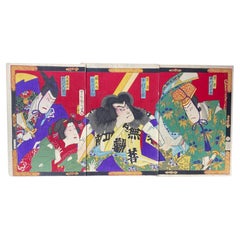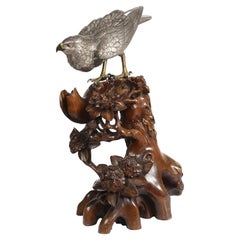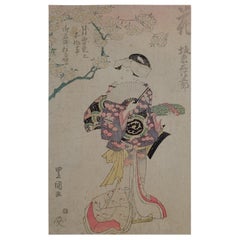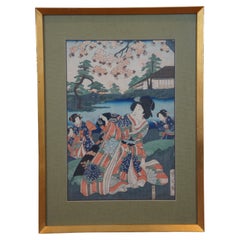Toyohara Kunichika
3
to
1
1
3
3
3
2
1
1
2
1
1
1
1
3
3
3
9
5,206
4,014
2,460
2,235
Creator: Toyohara Kunichika
Toyohara Kunichika Japanese Triptych Woodblock Print of Kabuki Theater Actors
By Toyohara Kunichika
Located in Studio City, CA
A wonderfully composed, beautifully, and richly colored triptych woodblock print by famed Japanese artist Toyohara Kunichika featuring four dramatic and quite intense Kabuki theatre ...
Category
Early 20th Century Japanese Meiji Toyohara Kunichika
Materials
Paper
Japanese Ukiyoe Print by Toyohara Kunichika
By Toyohara Kunichika
Located in Fukuoka, JP
Japanese Ukiyoe print by Toyohara Kunichika ( 1835-1900 )
Printed on Meiji 28 (1895)
Title: Gishi Meimeiden / Fuwa Kazuemon ( one of the 47 Ronin ) acted by Ichikawa Sadanji .
Kunichika studied with Ukiyoe artist Chikanobu from whom he received his artist name .
Then under Kunisada and began to produce actor prints...
Category
Mid-19th Century Japanese Antique Toyohara Kunichika
Materials
Paper
Japanese Silvered Bronze Model of a Goshawk, circa 1890
By Toyohara Kunichika
Located in Brighton, Sussex
A SILVERED-BRONZE MODEL
OF A GOSHAWK
By Kunichika, Meiji era (1868-1912),
late 19th/early 20th century
Naturalistically rendered, standing alert with its head lowered, its wings ...
Category
Late 19th Century Japanese Antique Toyohara Kunichika
Materials
Bronze, Silver Leaf
Related Items
Japanese Woodblock Print by Utagawa Toyokuni I
Located in Norton, MA
Japanese Woodblock Print by Utagawa Toyokuni I (1769~1852), original and unframed.
ABOUT THE ARTIST
Utagawa Toyokuni (Japanese: ????; 1769 in Edo – 24...
Category
Early 19th Century Japanese Antique Toyohara Kunichika
Materials
Paper
Japanese Meiji Toyohana Chikanobu Woodblock Print Triptych from Plum Garden Set
By Toyohara Chikanobu
Located in New York, NY
Japanese Meiji period framed set of three woodblock prints from the 'Plum Garden' series, made by Toyohana Chikanobu (1838-1912). An example of this print is at the Kanagawa Prefecture Museum in Yokohama.
The set dates from circa 1880. The first signature on the lower left corner is the publishers' name and address (Takegawa Unokichi), the second one in the upper right corner is the date 1889 and the third one in the lower right corner is 'Japanese Plum...
Category
1880s Japanese Meiji Antique Toyohara Kunichika
Materials
Paper
H 19 in W 35 in D 1 in
Kiyoshi Saito Signed Japanese Woodblock Geisha Print Maiko Kyoto 3
By Kiyoshi Saitō
Located in Studio City, CA
A beautifully and serenely composed woodblock print by famed Japanese printmaker Kiyoshi Saito. Many consider Saito to be one of the most important, if not the most important, contem...
Category
1960s Japanese Showa Vintage Toyohara Kunichika
Materials
Paper
Kiyoshi Saito Signed Japanese Woodblock Geisha Print Maiko Kyoto 2
By Kiyoshi Saitō
Located in Studio City, CA
A beautifully and serenely composed woodblock print by famed Japanese printmaker Kiyoshi Saito. Many consider Saito to be one of the most important, if not the most important, contem...
Category
1960s Japanese Showa Vintage Toyohara Kunichika
Materials
Paper
Rare Antique Japanese Carved Stone Garden House Model
Located in Bridgeport, CT
Rare and complete antique Japanese carved stone architectural model of a traditional Folk Cottage. The front of the cottage has an entrance doo...
Category
Early 20th Century Edo Toyohara Kunichika
Materials
Stone
Rare Antique Japanese Carved Stone Garden Cottage Model
Located in Bridgeport, CT
Rare and complete Antique Japanese carved stone architectural model of a traditional Folk Cottage. Having a doorway and grid window at the fron...
Category
Early 20th Century Japanese Folk Art Toyohara Kunichika
Materials
Stone
Japanese Signed Limited Edition Modern Abstract Framed Print
Located in Studio City, CA
A wonderful abstract Japanese print. Intense composition and colors.
Signed, dated (December 1990), numbered (8/30) and titled in Japanese by the artist.
Appears to be printed ...
Category
1990s Japanese Modern Toyohara Kunichika
Materials
Paper
Japan 1890 Meiji Period Rare Carved Okimono Of A Father And Son Playing Signed
Located in Miami, FL
Japanese Okimono sculpture of a father and son.
Very rare and highly detailed sculpture, created during the meiji period (1868-1912) in the imperial Japan, circa 1890. This sculptural Okimono is very well realized and exceptionally proportionate. Show the figures of a father and a son playing, with happiness and smiling. The father hold a big basket at his back and both personages are wearing kimonos richly engraved.
This piece was made from a carving with exceptional craftsmanship and intricate details. This sculpture stand itself on his own base and have all retain of the applied ochre ink accents.
Measures: 130 mm by 45 mm by 53.3 mm (5.1 x 1.75 x 2.1 inches).
Weight: 81.30 grams.
Note: This kind of family scene is very rare to seen in nineteenth century japanese iconography.
Okimono
Is a Japanese term meaning for display an ornament; art object; or decorative object, usually displayed in a tokonoma or butsudan "Buddhist altar". It is an ornament or figure, especially one placed in a guest room. An okimono may be a small Japanese carving, similar to but larger than a netsuke. Unlike the netsuke, which had a specific purpose, the okimono is exclusively decorative and was displayed in the tokonoma. During the Meiji period, many okimonos were made for export to the West.
Meiji Period
This is an era of Japanese history that extended from October 23, 1868 to July 30, 1912.The Meiji era was the first half of the Empire of Japan, when the Japanese people moved from being an isolated feudal society at risk of colonization by Western powers to the new paradigm of a modern, industrialized nation state and emergent great power, influenced by Western scientific, technological, philosophical, political, legal, and aesthetic ideas. As a result of such wholesale adoption of radically different ideas, the changes to Japan were profound, and affected its social structure, internal politics, economy, military, and foreign relations...
Category
1890s Japanese Meiji Antique Toyohara Kunichika
Materials
Wood, Paint
H 2.1 in W 5.1 in D 1.75 in
1965 Face 'Black', Woodblock Print by Tomio Kinoshita, Japan
By Tomio Kinoshita
Located in Point Richmond, CA
Tomio Kinoshita (1923 – 2014)
Face (Black), 1965
Woodblock print
Image size: 25 high by 18 inches wide (63.5 by 45.7 cm)
Paper size: 26.25 high by 19 inches wide (66.7 by 48.2 cm)
Unsigned
Condition: some wrinkling in the margins
This print is from a woodblock that was carved in 1965; Kinoshita would often experiment with colors and sometimes not sign the test prints. A green and black version of this image can be found in volume one of the two-volume 44 Modern Japanese Print Artists by Gaston Petit...
Category
1960s Japanese Mid-Century Modern Vintage Toyohara Kunichika
Materials
Paper
Japanese Woodblock Print by Utagawa Yoshiiku 落合芳幾
Located in Norton, MA
Japanese woodblock print by Utagawa Yoshiika 落合芳幾 (1833-1904), unframed.
About the Artist:
Yoshiiku was a popular ukiyo-e printmaker during the Meiji period. It is thought that he was the son of a tea house proprietor, hence his particular skill success in the portrayal of various beauties from teahouses and restaurants. Yet, he was an artist comfortable across subject matter and is recognized for his fierce portrayal of famous historical warriors. Yoshiiku was a student of Kuniyoshi and a contemporary rival of the famed Yoshitoshi. He signed his name Utagawa Yoshiiku...
Category
Mid-19th Century Japanese Antique Toyohara Kunichika
Materials
Paper
Japanese Painted Bronze Okimono of a Gourd by Toyo, Showa Era, 1960s, Japan
By Toyo
Located in Austin, TX
A charming Japanese decorative bronze sculpture, okimono, of a gourd, hyotan, by Toyo Japan, Showa Era, circa 1960s, Japan.
The realistic okimono, fashio...
Category
1960s Japanese Showa Vintage Toyohara Kunichika
Materials
Bronze
H 5.25 in W 11.25 in D 8 in
Japan 1890 Meiji Period Signed Assembling of Okimono with a Group of Skeletons
Located in Miami, FL
A signed Okimono from the Japanese Meiji period (1868-1912).
Very rare, unusual and large sculptural assembling of a dysplaying piece of okimono. Created in Japan during the imperial period of the Meiji (1868-1912). This extraordinary piece okimono sculpture depict a group of four intricately and realistically rendered carousing males skeletons representations (Gaikotsu) standing in several position.
One skeleton is crouched down playing with mouses in the floor. The second is seated resting in the other's back, peacefully smoking opium. The others two are fully standing in interacting position. The entire composition is arranged freely displayed on the wood base including a woven basket, apparently with food and four playfull mouses.
There are an extra five mouses in different positions, freely playing around, all of them with the eyes accented with carved black ebony.
The composition is displayed on a four-legged free form carved wood platform with an inlaid red plaque engraved with the artist's signature. The level of detail and the quality of the carving is truly exceptional.
Has an exact measurements of 216.15 mm by 139.7 mm by 359.41 mm (8.51 x 5.5 x 14.15 Inches).
After an extensive collection of data, comparables and references to this piece, we have only been able to find only three okimono sculptures like this, with similar themes and the same quality of work.
References Note: A similar carving of four skeletons playing an animated game of dominos, signed Shutaro in an inlaid rectangular red plaque, was sold in London by Christie’s South Kensington in October 14 2014, Lot 120 Sale 5546.
References Note: A similar carving with four skeletons in an otherwise typical victorian scene of a photographer and three sitters signed Shutaro in an inlaid rectangular red plaque, was sold in Edinburgh at Lyon & Turnbull in November 7, 2018.
References Note: A similar carving with five skeletons seated, playing cards and drinking, was sold in London by John Nicholson Fine Art on September 26, 2018.
Meiji period, is an era of Japanese history that extended from October 23, 1868 to July 30, 1912.The Meiji era was the first half of the Empire of Japan, when the Japanese people moved from being an isolated feudal society at risk of colonization by Western powers to the new paradigm of a modern, industrialized nation state and emergent great power, influenced by Western scientific, technological, philosophical, political, legal, and aesthetic ideas. As a result of such wholesale adoption of radically different ideas, the changes to Japan were profound, and affected its social structure, internal politics, economy, military, and foreign relations. The period corresponded to the reign of Emperor Meiji. It was preceded by the Keio era and was succeeded by the Taisho era, upon the accession of Emperor Taisho.
Okimono, is a Japanese term meaning for display an ornament; art object; or decorative object, usually displayed in a tokonoma or butsudan "Buddhist altar". It is an ornament or figure, especially one placed in a guest room. An okimono may be a small Japanese carving...
Category
1890s Japanese Meiji Antique Toyohara Kunichika
Materials
Wood
H 8.51 in W 14.15 in D 5.5 in
Previously Available Items
Antique 19th Century Toyohara Kunichika Japanese Edo Woodblock Print
By Toyohara Kunichika
Located in Dayton, OH
"Antique 1858 Japanese woodcut print by Toyohara Kunichika, showing four elegantly dressed Geishas in a garden under cherry blossom trees.
“...
Category
1850s Edo Antique Toyohara Kunichika
Materials
Paper
Toyohara Kunichika furniture for sale on 1stDibs.
Toyohara Kunichika furniture are available for sale on 1stDibs. These distinctive items are frequently made of paper and are designed with extraordinary care. If you’re looking for additional options, many customers also consider furniture by Yabu Meizan, Kinkozan, and Satsuma. Prices for Toyohara Kunichika furniture can differ depending upon size, time period and other attributes — on 1stDibs, these items begin at $500 and can go as high as $19,120, while a piece like these, on average, fetch $895.





